003: NANCY LORENZ
Nancy Lorenz is an abstract painter who uses mother-of-pearl, gold leaf, lacquer, and other traditional materials in her craft. You can see her work surround the Tiffany's Masterpieces collection in their NYC Landmark Store.
It's a shame that we grow tall before we grow up.
Staring into the 85 wood panels that line the Tiffany's Landmark Store’s 7th Floor in New York City, I wish to be two feet tall, press my finger — just a couple inches long — to a thick, clear line of resin and sprint down the hall. I want to pound my toddler fist into the ground with joy. Nancy Lorenz's panels glow.
There's something about the way light bounces around in that room, the way it leaps from jewel to jewel, pearl inlay to gold chain. There are a thousand jumping spiders — all invisible but for the light their eyes reflect — whizzing about on this floor. Each step and adjustment of sight sets loose this swarm of arachnid glimmer, these rivers of refraction that are so many eyes meeting your gaze and moving on. In this bounce-house of light — the home to Tiffany's "high jewelry" collection — Nancy Lorenz's panels serve as backdrop to the brand's most intricate pieces.
Pearl, pigment, white gold leaf, gesso, and resin, the wood panels are a treasure. Beneath the clear, jelly-gestured lines that suck light in and shoot it careening down the hall, beneath the scattered, in-laid circles of mother-of-pearl that spin between patina and purple, beneath all of this, a grid — 35 squares by 10, for each panel. If I were two feet tall, this discovery — among others, I'm sure — would've been immediate. At the eye-level of my adulthood, the grid gives way to washes of ink-in-water blue, a pond of faint indigo drops, and a haze. A raincloud, all moonlight and metal, rolls into frame. Down below, where the little me looks, a darker gray reigns, and the thick clear lines shuttle shadow in lieu of light.
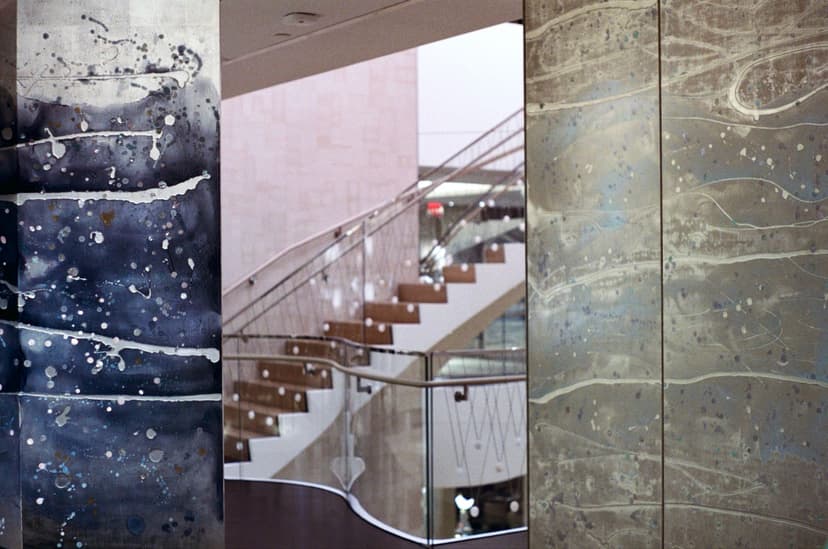
The grid makes legible the rhythm of the panels' curve. In the angle at which they stand, the panels alternate. One tilts away, the next opens up. The current that this dance gives off feels incidental, off in the slightest way, casual; for lack of a better word: natural. This must be the way they decided to open this morning, you think. Then you see. Each one is a flat rectangle pressed flush to the wall, and it is the wall itself — rather than the panel — that undulates.
That’s the room’s power: it drains from permanence its stiffness. What’s left is a trace of time that – though changing and in motion – recurs. Lorenz’s panels give to what is concrete and fixed a mercurial sense of movement and possibility. In this hall that must be some pirate's fantasy, even the walls ebb and flow.
Of Ginkaku-Ji and other wooden temples in Kyoto, Italo Calvino writes: "In Japan, antiquity does not have its ideal material in stone as in the West, where an object or building is considered ancient only if it is conserved in its substance. Here we are in the universe of wood: what is ancient here is that which perpetuates its design through the continual destruction and renovation of its perishable elements."
The wooden temple does not cling to a specific composition: like a body, its cells replace themselves, over and over. The pillars are felled and found anew; the trees in the garden, pruned and replanted; the roof remade. The stone cathedral's antiquity, on the other hand, comes from its unbending trajectory toward ruin and its preservation of the material that constituted its origin. Over the next ten decades, there will be new watches, new jewels, and new necklaces that fill this room. Small armies of black-coated attendants will attend to the glass, much like monks will care for their pebbles and plants. But, like the temples guarding and watching over their gardens of change, Lorenz's panels, too, will watch over their own zone of attention. Art as decoration does that, it seems — it belongs to its space, and it affects it deeply. It’s hard to imagine her panels in any other room but this one. They have bent even the walls to their vision, and they will remain, perpetuating their movement in this room that will continue to change with time, as every house – especially one built for commerce – does.
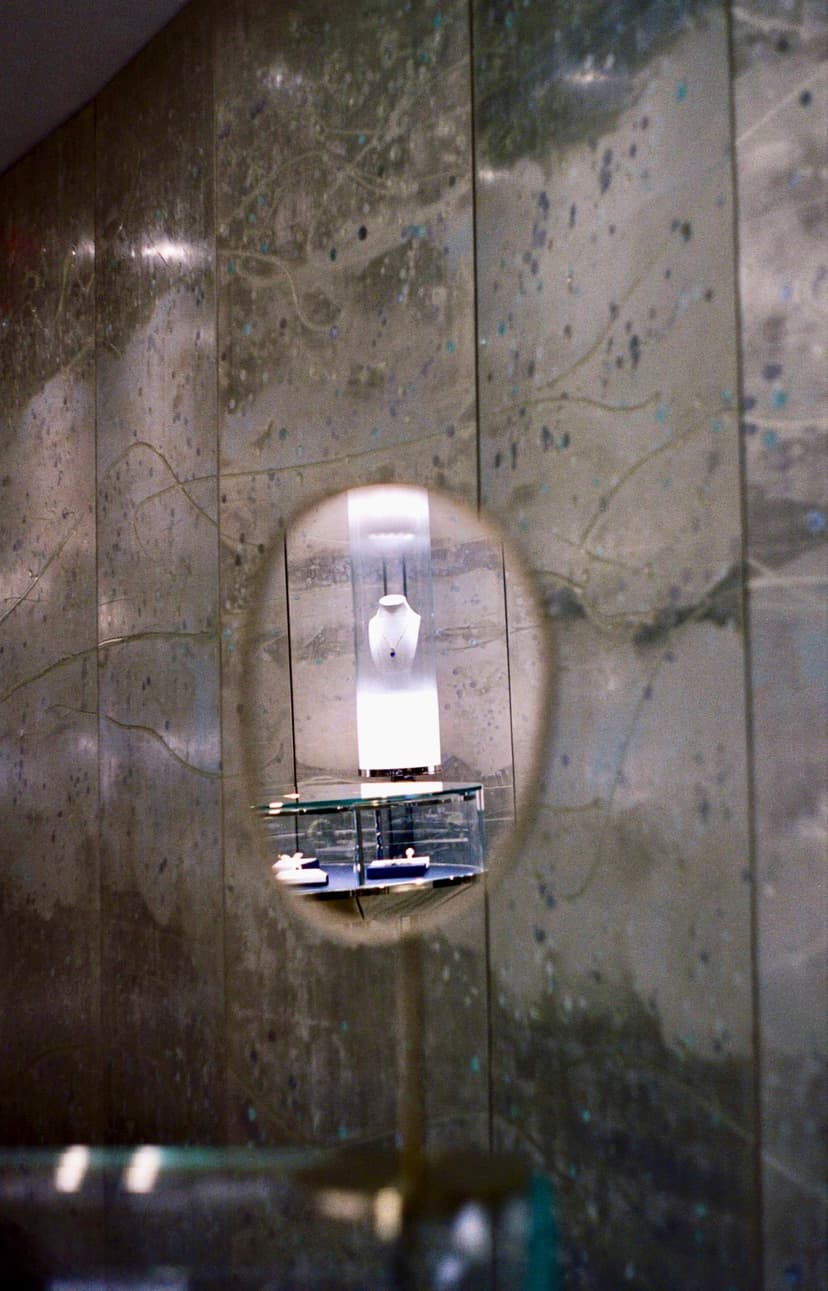
Between the jewelry and Lorenz's work, an electricity crackles. Walking into Lorenz's Astoria studio, just up the road from the Ravenswood Generating Station's towering shadow, you feel a similar charge. When we visited her space, one of her assistants silently opened the door, and, after gesturing us toward Lorenz, returned without much to say to a small box he was diligently painting. Lorenz welcomed us in and walked us through the body of work she's been building for more than forty years.
She told us about the influence her time in Japan as a child had on both her work and her sense of self, about building an antique restoration business alongside her studio practice, about collaborating with designers like Peter Marino (who led the Tiffany store's renovation). Nearly everywhere you look in the bright, open space, you see both a wide variety of materials — burlap, wood, metal, paper, lacquer, Aqua-Resin — and a wide variety of sizes. Many of the pieces she stores here are preparatory works for large-scale commissions, including four massive gilded banners that hung from the Basilica di Santa Maria (dubbed "the Church of the Artists") earlier this year. Others explore niches that seem utterly unrelated on the surface — in 1998, she received a Guggenheim Fellowship to spend a year building a body of work inspired by the periodic table of elements.
A layer below that apparent divergence, though, a uniting thread begins to emerge: her work, whether from the 90s or from earlier this year, has this utter fascination with light. In her work for Tiffany’s, pearls, paint and line invite the fine jewelry they frame into a kind of sparkling dance.
In the piece pictured below, a thick, metallic cloud sends out rays like anchors across the frame. From her boxes covered in frozen flows to her massive rolls of reflective fabric to all the gold, silver, and palladium leaf clinging to her surfaces, it seems like each of her pieces come alive only when they catch a bit of sunlight and send it our way, changed indelibly by what it just touched.
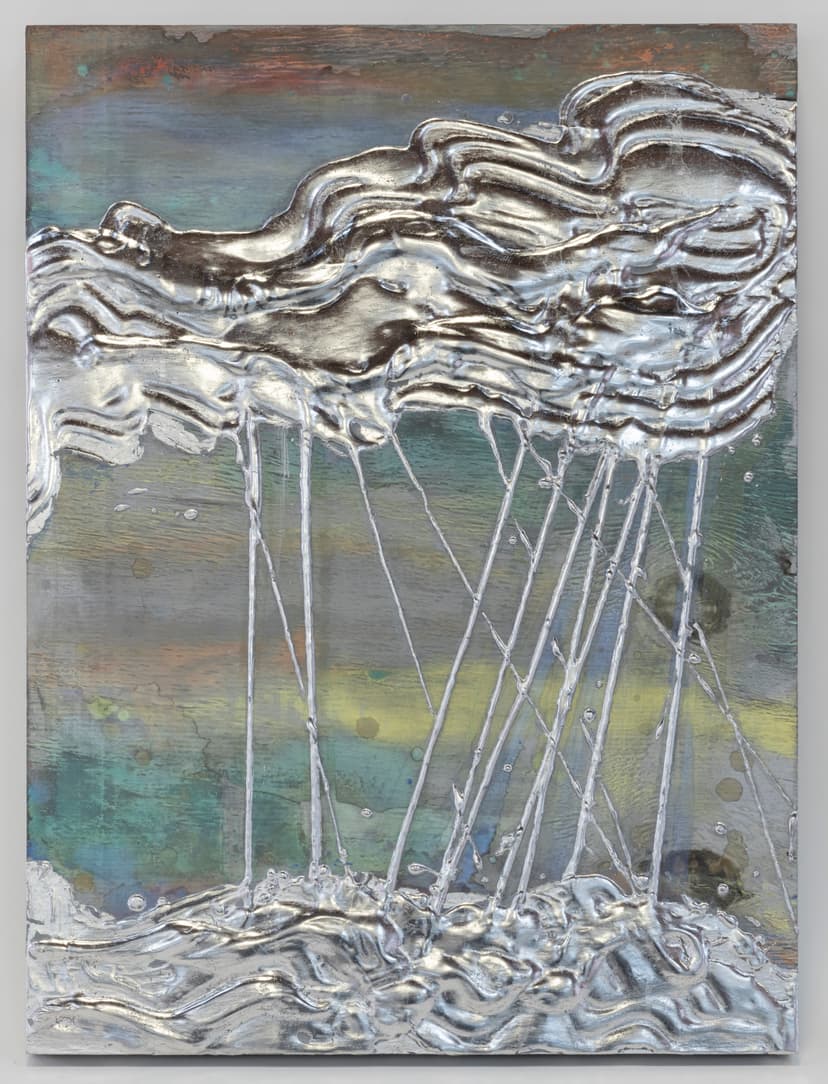 Moonlight, 2023
Moonlight, 2023After her detailed tour, I sat down on a little step-stool next to a shelf filled with work she made from 2006 to 2010. (I was happily two feet tall.) Nestled in between lustrous gold and pearl paintings, I found two boards covered with what looked like little glass beads and faint blue and purple zones of color. I told her that the blue one reminded me of Antoine de Saint-Exupéry's The Little Prince, and, after thinking for a moment, she recalled that these two paintings were part of a series inspired by different buddhas she had come across.
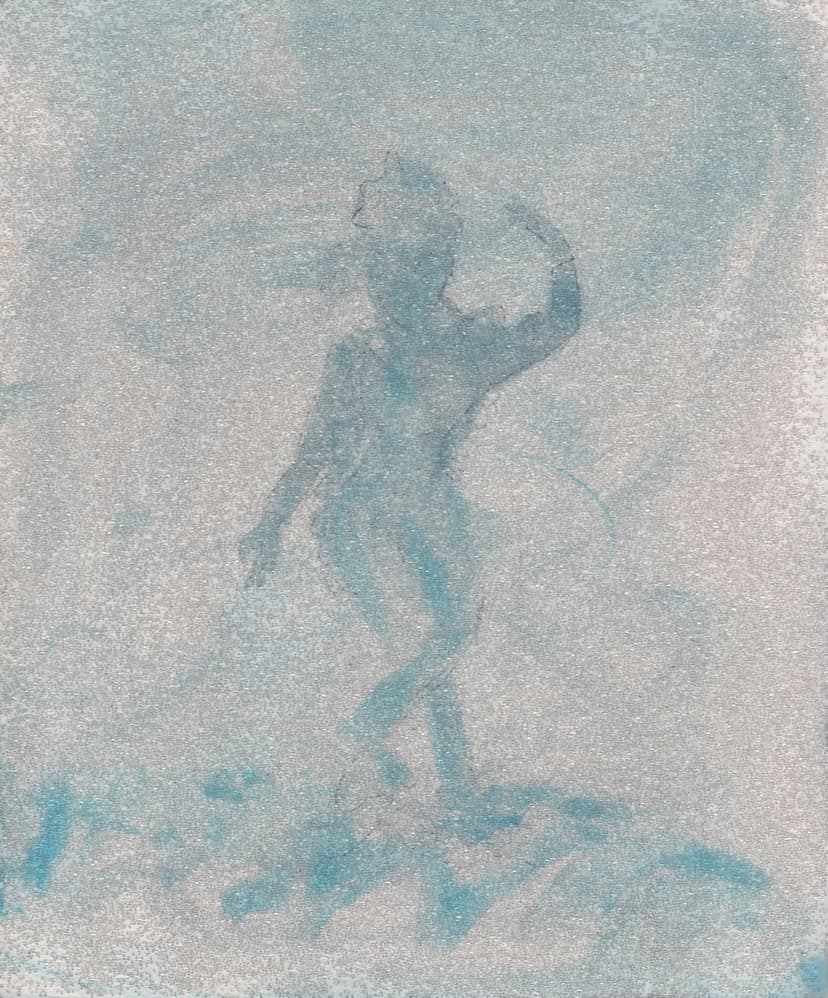 Radiant Figure, 2010
What, in this buddha with a body curled like a question, did I see that brought to mind so vividly that baby blonde astronaut, bouncing around from planet to planet? In this figure who seems to both emerge and fade away in the same pale blue moment, there is the unmistakable imprint of a shadow. Though not a silhouette clearly defined, the dancer's form brings with it a wispy sense of being (or of having been) that weighs upon the air like smoke. Beneath all the tiny beads that slice her studio's sunlight into a mosaic of shimmer, Lorenz's buddha lures us into that thinnest of spaces — the hollow between the surface and its shadow.
Radiant Figure, 2010
What, in this buddha with a body curled like a question, did I see that brought to mind so vividly that baby blonde astronaut, bouncing around from planet to planet? In this figure who seems to both emerge and fade away in the same pale blue moment, there is the unmistakable imprint of a shadow. Though not a silhouette clearly defined, the dancer's form brings with it a wispy sense of being (or of having been) that weighs upon the air like smoke. Beneath all the tiny beads that slice her studio's sunlight into a mosaic of shimmer, Lorenz's buddha lures us into that thinnest of spaces — the hollow between the surface and its shadow.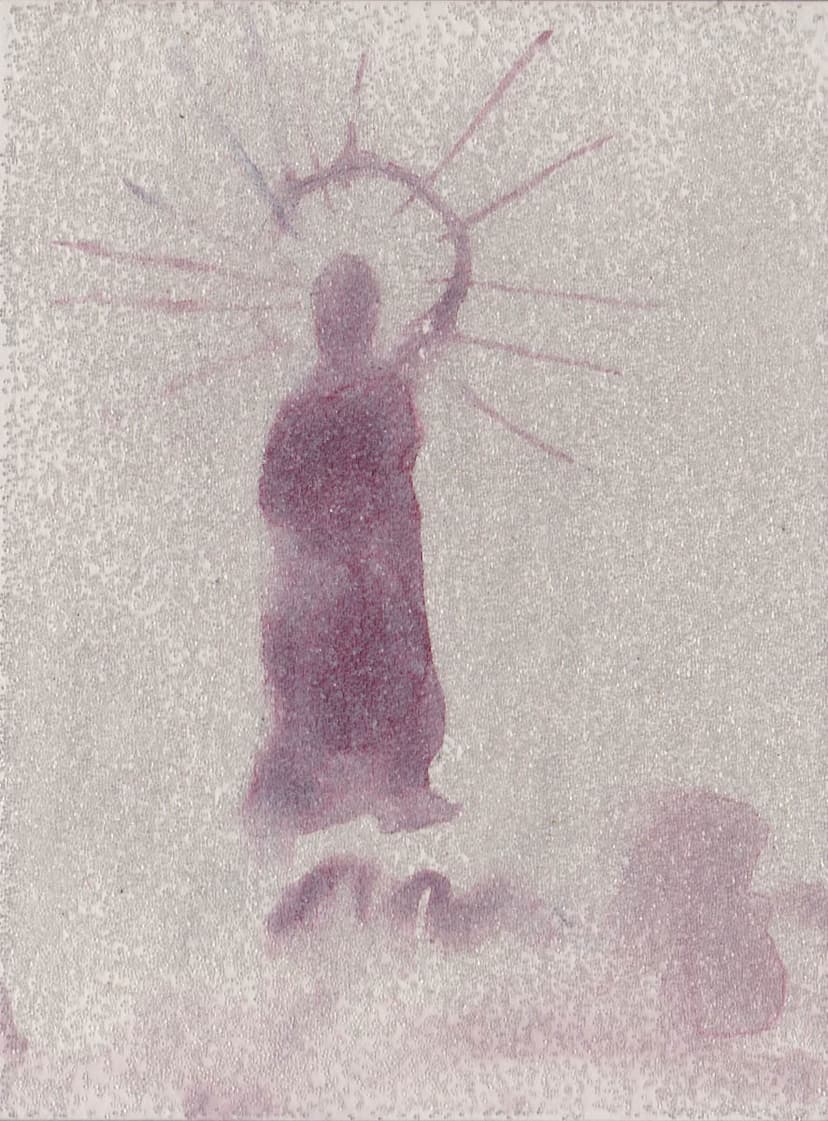 Goddess, 2010
Goddess, 2010On the importance of seeing Japanese lacquerware — a chief influence in Lorenz's practice — in the dark, Junichiro Tanizaki writes, "Only in dim half-light is the true beauty of Japanese lacquerware revealed … the sheen of the lacquer, set out in the night, reflects the wavering candlelight, announcing the drafts that find their way from time to time into the quiet room, luring one into a state of reverie … indeed the thin, impalpable, faltering light, picked up as though little rivers were running through the room, collecting little pools here and there, lacquers a pattern on the surface of the night itself."
And in her twin buddhas — though seen in the full brightness of day — I can hear whispers of that dribbling stream. Sight gives way to a sound that does not submit to your ears but rather rushes in, breathless, through the eyes.
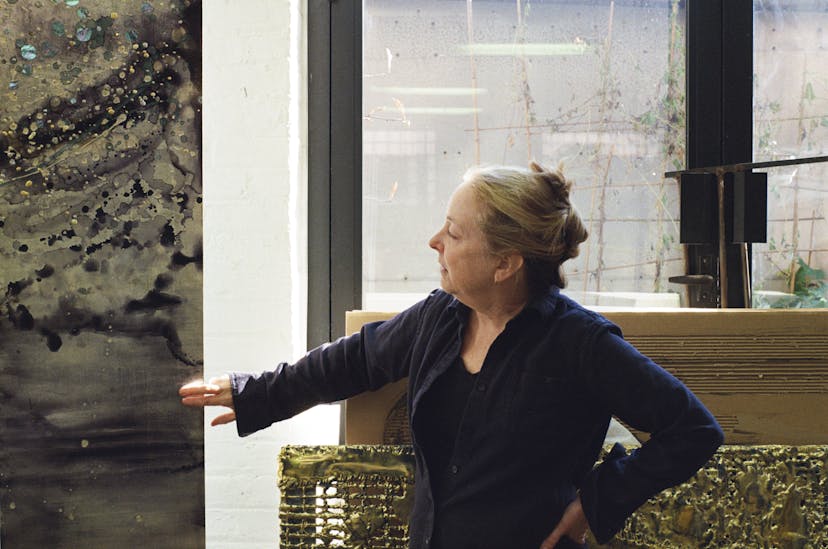
Lorenz’s crowning achievement is that she finds a way to wrest Tanizaki's spectral attention from the dark and ushers it into rooms filled with light. The jewels in Tiffany's 7th Floor; the Church of the Artists in Montesanto; her own studio walls. In each of these spaces, light is essential. With her lacquerware, with her pearls, with her silver, with her matte flows, Lorenz finds a way to play with this brightness, to invite it into the kind of dance in which her buddha finds himself frozen.
It is a duet with what we cannot yet see but know to be there. To stare at her work is to catch your eyes mid-flight, clinging to gesture and wading, gently, in the river that runs between what you call light and dark.
— Gopal Raman (photos by Noelle Kim)